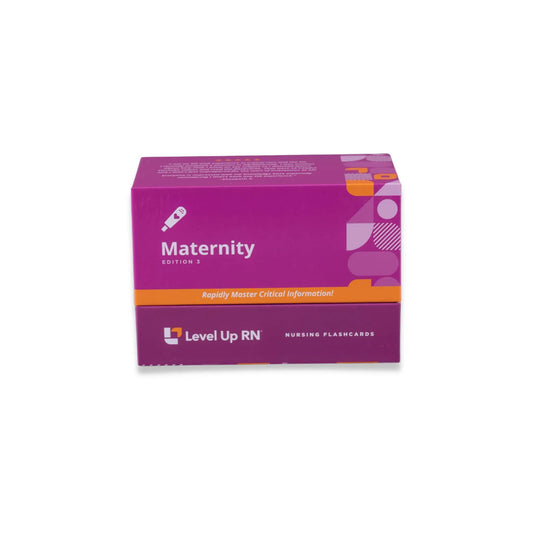Maternity Nursing - Flashcards
This article discusses the stages of labor, as well as the difference between effacement and dilation. The Maternity Nursing series follows along with our Maternity Nursing Flashcards, which are intended to help RN and PN nursing students study for nursing school exams, including the ATI, HESI, and NCLEX.
Stages of labor
There are four stages of labor, conveniently named stages one, two, three, and four, or first, second, third, and fourth stage.
First stage of labor
The first stage of labor is divided into three phases, the latent phase, the active phase, and the transition phase. These commence at the onset of labor and last until the cervix is fully dilated (10 cm).
Latent phase
In the latent phase, the cervix is dilated 0 – 3 cm, and the patient experiences mild to moderate contractions around 5 minutes apart. Pain is probably not an issue yet.
During this phase, Mom is excited and talkative: “Oh my god, the baby’s actually coming. I can’t believe it’s time.”
Active phase
In the active phase, the cervix is dilated 4 – 7 cm, and the contractions are growing stronger and occurring 2 – 5 minutes apart.
During active labor, Mom may become more apprehensive, intense, and inwardly focused: “This is starting to hurt a lot. I’m getting a little bit nervous about it."
Transition phase
In the transition phase, the cervix is dilated 8 – 10 cm (full dilation), and contractions are strong to very strong, occurring 1.5 – 2 minutes apart.
The hallmark signs of the transition phase of labor are if Mom feels a very strong urge to push or says, “I need to have a bowel movement,” which is probably due to rectal pressure from the baby being so far into the pelvis.
Another sign is if Mom starts verbalizing fear or apprehension like, “I can't do this,” or, “I don't want to do this anymore,” or, “I don’t think I can take it much longer.” At this point, it is important to give Mom emotional support and reassurance: “You’re doing so great. You’re so close to the finish line. I need you to take a couple of deep breaths and we’re going to get through this together.”
Second stage of labor
The second stage of labor is the time from complete dilation of the cervix (10 cm) until the delivery of the baby. During this stage, Mom feels an overwhelming urge to push.
Third stage of labor
The third stage of labor is from when the baby is born until the placenta is delivered.
Fourth stage of labor
The fourth and final stage of labor is from the time the placenta is delivered until the time that Mom has been stabilized, that is, back to the pre-labor baseline.
Effacement vs. dilation
During labor, you may hear things like a patient is “100% effaced and 6 centimeters dilated.” This is a description of the progression of the cervix during labor — how thick or thin it is, and how wide it is opening.
Effacement
Effacement has to do with the thinning of the cervix.
The cervix starts out thick and closed. With the beginning of strong contractions, the cervix starts to get thinner. This is because it is stretching upward as contractions occur.
Effacement is referred to in percentages from zero to 100%.
Dilation
Dilation has to do with how wide the cervix is getting (opening) and is measured in centimeters.
On the flashcards, you’ll see a set of diagrams that visualize this process. At the start, the cervix is zero percent effaced with no dilation. Then it transitions to 50% effacement with no dilation as the baby begins to move down. Next, as the baby moves further down, the cervix is fully effaced and 5 centimeters dilated (labor is well underway!). Finally, at birth, the cervix is fully effaced and dilated to 10 cm (here comes the baby!).



1 comment
I have the flash cards and I read them. All your guys video helps make it so much more understandable. Thank you for ALL you do.